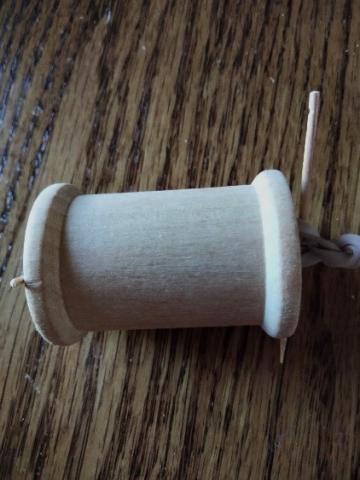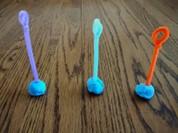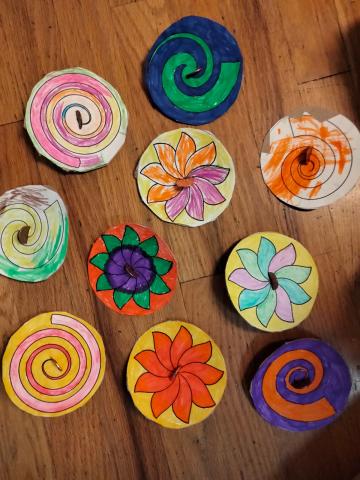

Free materials for this Take and Make will be available at area PPLD libraries beginning Dec. 9, 2023.
Materials provided:
Spool
Washer
Rubber Band
Toothpicks
Materials you provide:
Scissors
Tape
Markers, if desired
Directions: (see additional pictures in the pdf link below)
1. Use markers to decorate the spool, if desired.
2. Push the rubber band through the center of the spool. Use a toothpick to help poke it through if needed.
3. Break a toothpick, slide it through one rubber band loop, and secure it to the spool with tape.
4. Slide the washer onto the rubber band loop at the other end of the spool.
5. Insert a toothpick through the loop.
6. Wind the toothpick.
7. Set it down on a smooth surface and let go. Watch it race or spin!
8. Experiment with how you can adjust it to make it go straighter or farther. You can also race your friends.

How does your brain understand how far away something is? This experiment shows how your eyes work together to perceive distance.
Our eyes both face the same direction. Because they do, they produce slightly different views of the same object. Our brains are able to use this overlapping information (retinal disparity) to figure out how far away an object is. (If our eyes were on the sides of our heads like some animals, we would have poor depth perception.)
Try this: Close one eye and focus on a nearby object. Switch which eye is open and focus on the object again. You should see the object shift. Try it again with a faraway object. When you use just one eye, your brain can’t use feedback from both eyes to discern depth perception.
Materials needed:
Pipe cleaners – use half for each
Clay
Scissors
Pencils
Instructions:
1. Cut your full pipe cleaner in half. Use ½ pipe cleaner for each.
2. Bend the end of a pipe cleaner so you have a circle that’s slightly bigger than a pencil. Twist it to secure.
3. Use a bit of clay to make a stand for the pipe cleaner.
4. Make 2 more pipe cleaner stands with slightly bigger circles. You should have 3 pipe cleaners on stands.
5. Test your depth perception – Place the pipe cleaner with the largest opening on a table in front of you so you cannot see the opening. Close one eye and try to put the pencil through the hole. Try it again with both eyes open. Which is easier? Try it with each sized hole and see the difference.
6. If this is too easy, try getting a needle and thread and threading the needle with one eye closed!
Based on: https://www.kiwico.com/diy/stem/anatomy-biology/seeing-depth-perception

Take and Makes for this project will be available at area PPLD libraries on Oct. 14, 2022.
Supplies and Directions:
Materials we provide:
Paper Templates
Cardboard
Materials you provide:
Scissors
Penny
Glue
Markers, Crayons, or Colored Pencils
Directions:
Color your template. Glue the template to the cardboard. Cut out around your template.
Cut a small slit in the center of the circle to insert the penny. The slit needs to snugly hold the penny.
Spin. As it spins, note what you see.
The Science Behind it: Something in motion stays in motion unless a force acts upon it. In Penny Spinners, the friction between the penny and the surface slows it down and eventually causes it to stop. This project also shows color mixing as the colors combine when the spinner spins.


